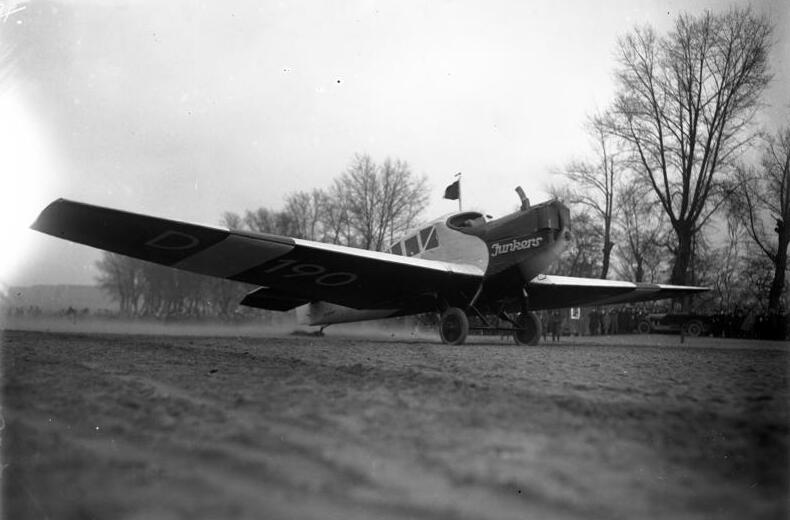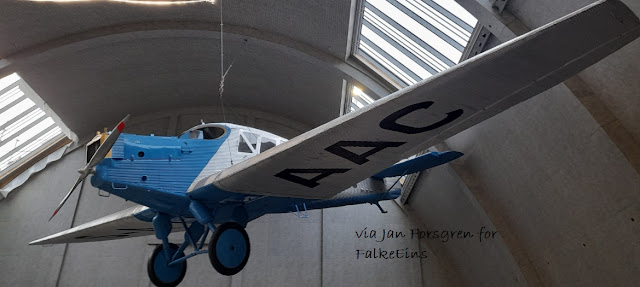
F13 taking off from Tempelhof on March 7, 1923 with the Weimar Reichs President Friedrich Ebert on board - Flugzeugreise des Reichspräsidenten zur Leipziger Messe am 7. März 1923 - Start des Flugzeuges mit dem Reichspräsidenten auf dem Tempelhofer Feld. F 13 fy D-190 of Lloyd Ostflug then Junkers Luftverkehrs AG.
..and nearly one hundred years later..
Back in 2019 the Czech city of Zlín restored and re-opened its memorial to the town's most famous entrepreneur - Tomáš Bata. His footwear business - one of Czechoslovakia's leading exporters - brought prosperity and renown to Zlin. Why is this of interest for aviation enthusiasts? Tomáš Bata was a promoter of Czech aviation and owned and flew a Junkers F13. He made business flights in F13 D-1608 until he and his pilot were killed in a crash on July 12, 1932. A full-size replica of his machine was constructed for the restored museum - it is notable for having been created entirely with a 3D printer! Visitors can marvel at the replica in the new building.
A number of other replicas of the F13 have been built over recent years. A replica F 13a stood on the apron of the Hugo Junkers hangar at Mönchengladbach Airport for a while and since 2017, a replica of the F 13 has been on display at the Luftfahrttechnisches Museum Rechlin. There is another reproduction in the Junkers Museum Dessau and, since 2019 an F-13 simulator that has been in operation. The Rimowa company built two flying replicas in Switzerland. HB-RIM flew for the first time in 2016 from Dübendorf Airport and HB-RIA followed three years later.
(Variants of the F13 were built using Mercedes, BMW, Junkers, and Armstrong Siddeley Puma liquid-cooled inline engines, and Gnome-Rhône Jupiter and Pratt and Whitney Hornet air-cooled radial engines. The variants were mostly distinguished by a two letter code, the first letter signifying the airframe and the second the engine eg, Junkers L5-engined variants all had the second letter -e, so type -fe was the long fuselage -f airframe with a L5 engine).
" ..Sie haben die Fliegerei revolutioniert: die weltbekannte „Tante JU“ und die vergessene F13, die „Urmutter“ aller Verkehrsflugzeuge. Im Jahr 1919 begründete die weltweit erste Gesamtmetallmaschine mit dem markanten Riffelblech die moderne Passagierluftfahrt. Bis in die 60er Jahre verband die F13 Menschen und Kontinente. Anfang 2013 erwecken die Mitarbeiter bei Kaelin Aero Technologies, im deutschen Schwarzwald, die Ikone der Luftfahrt zu neuem Leben. Flugzeugstrukturbauer Dominik Kälin rekonstruiert aus dem Material, mit dem Hugo Junkers seine Flugzeuge und Paul Morszeck seine berühmten Rillen-Koffer baute, die F13. Dominik Kälin, Flugzeugstrukturbauer, Kaelin Aero Technologies: „Es ist eigentlich ein physikalisches Grundprinzip, was der Herr Junkers damals genutzt hat und auch der Vater von Dieter Morszeck. Die waren clever. Cleverer als die anderen...“
"..They revolutionised aviation: the world-famous "Auntie Ju" and the forgotten F13, the original "mother" of all commercial aircraft. In 1919, the world's first all-metal aircraft constructed with its distinctive corrugated aluminium alloy (duralumin) sheet established modern passenger aviation. Up until the 1960s, the F13 connected people and continents. In early 2013, the employees at Kaelin Aero Technologies, in the German Black Forest, brought the icon of aviation back to life. Aerostructures engineer Dominik Kälin built his F13 from the same metal sheet material that Hugo Junkers used to build his aircraft and Paul Morszeck (Rimova kuggage) his famous grooved suitcases. Dominik Kälin, Kaelin Aero Technologies: "It's actually a basic physical principle that Mr Junkers used back then and also Dieter Morszeck's father. They were clever. Cleverer than the others..."
"...Rückkehr einer Legende – das weltweit erste Passagierflugzeug – die JUNKERS F13 hebt wieder ab. Seit fast 3 Jahren produziert ah-tv eine Dokumentation über den Nachbau der „Mutter“ aller Verkehrsflugzeuge. Kurz vor der Weltpremiere des Erstflugs am 15. September 2016, haben wir den wohl einzigen noch lebenden F13 Zeitzeugen getroffen. Hans-Walter Bender erzählt uns exklusiv von seinem unvergesslichen Erlebnis, als er 1929 als 6jähriger Junge mit seiner Mutter Charlotte einen an einem Rundflug mit der JUNKERS F13 teilnahm. Seine persönlichen Erinnerungen werden wieder lebendig durch historische Filmaufnahmen, (Quelle: Archiv Bernd Junkers) Fotos und das original Flugticket von damals..."
An interview with Hans-Walter Bender - perhaps the last person still alive to have flown in the Junkers F 13 which he did as a six-year old in September 1929..
There are still five original F13s in the world, one in the Deutsches Museum in Munich, one in the Musée de l'Air in Paris, and examples in the museums in Stockholm and Budapest. The fifth W.Nr. 2050, built in 1930, stood for a long time in the Western Canada Aviation Museum in Winnipeg and came to Germany in September 2005. Restored in Hungary, it has been in the Deutsches Technik Museum in Berlin since 2020.
Below; the Junkers F 13 at the National Museum of Science and Technology in Stockholm via Jan Forsgren
Also on this blog;









